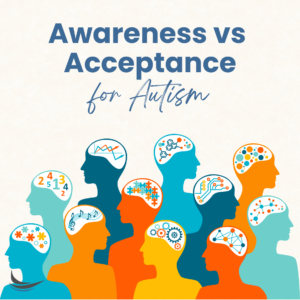 World Autism Awareness Day is observed this year on Sunday, April 2nd, 2023, and the entire month of April is focused on autism acceptance. The name change to Autism Acceptance Month is important.
World Autism Awareness Day is observed this year on Sunday, April 2nd, 2023, and the entire month of April is focused on autism acceptance. The name change to Autism Acceptance Month is important.
Yes, we want to be aware of autism, and here are some statistics that are important to know:
According to 2023 data from the CDC, approximately 1 in 36 children in the US has been identified with autism.
In 2020, the numbers were 1 in 54, and in 2000, 1 in 150 children.
If you were a child in the ’90s, rates were 1 in 1,000!
If you were a child in the ’70s, rates were 1 in 10,000!!
Check out this video for a visual graph of autism rates: https://www.youtube.com/watch?v=Z4sTYC3M7Lk
Better screening and awareness of developmental disabilities in childhood greatly account for the increase in children identified. We are learning more about identifying symptoms associated with autism and identifying what this looks like across the lifespan.
Autism Spectrum disorder (ASD) is known as a neurodevelopmental disability. Autism and what was formerly known as Aspergers Syndrome are both now part of the same spectrum, differentiated by level of impairment. Individuals with ASD have challenges with social communication and social interactions. They also display restricted or repetitive behaviors or interests.
For specific examples of what this might look like, check this out:
https://www.nimh.nih.gov/health/topics/autism-spectrum-disorders-asd
There is an important distinction between awareness and acceptance. This is especially true for a person with autism. Truly seeing someone for who they are and being inclusive within your spaces goes beyond knowing statistics and information.
We can all learn from tips to promote acceptance and inclusion as being inclusive starts with examining one’s attitudes and actions. Having an awareness of autism as a neurotypical person is different than living as an autistic person. Get to know parents of children with autism and the experiences of those who identify as autistic.
Use language that is preferred by the individual as this may differ from the person-first language (e.g., a person with autism) that is commonly used in professional and educational settings. Since autism is often an integral part of one’s identity, language that puts identity first is often used. It is important to ask others what language they would like you to use.
Have discussions and expose children to diverse persons by reading books that celebrate those who are different and make intentional efforts to include rather than exclude. This starts in early childhood and should continue into adulthood.
Speak up to educate and advocate. Parents of autistic children quickly learn to become advocates, especially within the educational setting to help work with issues such as bullying, educational accommodations, and support for behavioral challenges.
Be available to support teens and adults with autism with understanding social nuances they may struggle with in relationships such as navigating dating. Peers are an essential part of social learning and having opportunities to learn from a trusted friend or colleague can make a huge difference. Encourage self-advocacy in settings such as high school, college, and the workplace.
These are just a few steps that can help create more inclusive spaces and promote acceptance.
Written By: Charlotte Johnson, MA, LPCC
We’re Here to help
Our wellness experts will be happy to take care of you. You can CLICK HERE to schedule an appointment now or call (612)223-8898.
Meet Clinicians
We’re united by our commitment to providing effective, relevant, and innovative mental health support at all stages of your journey. Click Here to find a therapist or find out more about who we are, where we come from, and how we live out CARE’s mission every day.
The professionals at CARE are actively collecting and creating resources to help with what you need and address frequently asked questions. We’re Here for You.



